|
CLICK BUTTON TO GO |
|
|
|
|
|
|
|
|
|
|
|
|
|
Videos |
|
|
|
|
|
|
|
|
|
|
|
|
|
PART 1 T O P I C |
|
|
|
|
|
|
|
|
|
|
|
|
|
|
|
|
|
|
JewishWikipedia.info
RESPONSIBILITY FOR THE HOLOCAUST
Wikipedia Go to this site for more detail
Responsibility for the Holocaust is the subject of an ongoing historical debate that has spanned several decades. Intentionalist historians such as Lucy Dawidowicz argue that Adolf Hitler planned the extermination of the Jewish people from as early as 1918, and that he personally oversaw its execution. Functionalists such as Raul Hilberg have argued that the extermination plans evolved in stages, as a result of initiatives from bureaucrats who were responding to other policy failures.
WHO AUTHORIZED THE KILLINGS?
Hitler authorized the mass killing of those labelled by the Nazis as "undesirables" in the T-4 Euthanasia Program. Sometime between late June 1940 when planning for Operation Barbarossa first started and March 1941, orders were approved by Hitler for the re-establishment of the Einsatzgruppen (the surviving historical record does not permit firm conclusions to be drawn about the precise date). Hitler encouraged the killings of the Jews of Eastern Europe by the Einsatzgruppen death squads in a speech in July, 1941, though he almost certainly approved the mass shootings that occurred earlier.[citation needed] A mass of evidence suggests that sometime in the fall of 1941, Himmler and Hitler agreed in principle on the complete mass extermination of the Jews of Europe by gassing, with Hitler explicitly ordering the "annihilation of the Jews" in a speech on December 12, 1941, by which time the Jewish populations in the Baltic states had been effectively eliminated. To make for smoother intra-governmental cooperation in the implementation of this "Final Solution" to the "Jewish Question", the Wannsee conference was held near Berlin on January 20, 1942, with the participation of fifteen senior officials, led by Reinhard Heydrich and Adolf Eichmann, the records of which provide the best evidence of the central planning of the Holocaust. Just five weeks later on February 22, Hitler was recorded saying "We shall regain our health only by eliminating the Jew" to his closest associates. Nevertheless, no written order from Hitler exists.
MORE THAN 70 YEARS LATER, THE PROSECUTION OF A 94-YEAR-OLD FORMER SS GUARD RENEWS QUESTIONS ON ASSIGNING BLAME FOR THE HOLOCAUST
Time by Eliza Gray/Detmold, 2017
(Go to the top of the Time page for a video of court proceedings)
On a cold, gray morning in February, Irene Weiss was waiting patiently in the courtroom in Detmold, a small city in northern Germany. She had come a long way from her home in Virginia to testify in the trial of Reinhold Hanning, a former Nazi SS guard. The trial was off to a late start because Hanning, 94, was waiting for a wheelchair to take him into court. Because of Hanning’s health and age, the trial was restricted to only two hours of court time, two days per week. Every delay meant the 85-year-old Weiss might have to stay in Germany longer than she had planned. And she had already been waiting for this moment a very long time.
Finally, Hanning was wheeled through the entrance in a jacket, glasses and a canary yellow sweater, his chin pressed down into his chest to avoid looking into the cameras wielded by dozens of journalists in the courtroom. It was difficult to imagine that the frail old man had once been a young guard at Auschwitz. Hanning had been charged with being an accessory to murder in the deaths of 170,000 people killed at the death camp while he served there from January 1943 to June 1944. Weiss, who was a 13-year-old Jewish prisoner at Auschwitz during that period, and whose family was killed at the camp, was one of several witnesses testifying in the case brought by a city prosecutor in northern Germany.
Weiss doesn’t remember Hanning personally. None of the camp survivors who have testified at the trial do. But to the court at Detmold, that didn’t matter. They were there to paint a picture of what it was like in Auschwitz, and what role Hanning would have played as one of the thousands of SS personnel who served there. Thanks to a new legal strategy meant to hold even low-ranking ex-Nazis broadly responsible for the Holocaust, it’s become easier to prosecute cases against aging defendants—even without evidence of what specific acts individuals like Hanning may have committed more than 70 years ago.
Not everyone is comfortable with the idea of prosecuting the very elderly. But some experts believe these trials have a moral purpose that goes beyond black-and-white legal responsibility. “The optics are not brilliant, obviously,” says Lawrence Douglas, a legal scholar at Amherst College who has studied Nazi crimes. But these new trials are considered symbolically important, a way to show that a German legal system that struggled for decades to hold ex-Nazis accountable can finally bring them to justice.” As Douglas puts it, “It is better late than never.”
After the Allies tried top-ranking members of the Third Reich in a series of 13 military tribunals at Nuremberg from 1945 to 1949, a newly partitioned Germany took over prosecution of the remaining Nazi criminals. While communist East Germany’s trials were highly ideological—politics often trumped justice—democratic West Germany struggled as well. Allied attempts at “denazification” had largely failed—as of 1945, historians estimate that as many as 8 million people, about 10% of the total German population, were former members of the Nazi party, which meant the judiciary was filled with judges with Nazi connections. Rather than use a 1954 law specifically tailored to genocide, the West German justice system decided to pursue these crimes under the German penal code, effectively treating deaths in the Holocaust like any other murder. That meant prosecutors had to prove that defendants were personally guilty of killings—a high bar because of the bureaucracy of the death camps. “That was probably a cardinal mistake,” says historian Edith Raim, an expert on West German prosecutions of Nazis.
The German government did keep investigating crimes through a central office established in 1958 in Ludwigsburg in southwest Germany. Their work led to the most infamous series of Nazi prosecutions: trials in Frankfurt from 1963 to 1965 of 22 second- and third-tier Auschwitz personnel. Many defendants argued successfully that they had only been following orders, so that even soldiers who had shot and killed prisoners could be convicted only on lesser charges. In the end, only the worst sadists were convicted of murder. Of the 17 found guilty of a charge, just six were sentenced to life in prison, while the others received sentences ranging from three to 14 years.
Little changed in the years that followed. While perhaps 1,000 camp personnel faced trials in other countries, a now-united Germany has convicted fewer than 50 of the estimated 6,000 to 7,000 SS who served at Auschwitz and survived the war, according to German historian Andreas Eichmüller. So in the early 2000s, in an effort to increase the conviction rate, prosecutors at Ludwigsburg turned to a strategy suggested in the 1960s by Fritz Bauer, the attorney general of the German state of Hesse, who had been involved in the Frankfurt trials. Bauer, who had himself been imprisoned as a Jew in a concentration camp, argued that anyone who served in Auschwitz should be held responsible because they had been part of a killing machine.
The strategy succeeded for the first time in 2011 with the conviction of John Demjanjuk, a Ukrainian guard at the Sobibor death camp. “With the Demjanjuk case, they finally created a prosecutorial approach that got the logic of genocide down: if you were working in a factory of death, that made you an accessory to murder because your job was to facilitate the killing of human beings,” says Douglas, the Amherst historian. “That’s an incredible legal breakthrough.”
After Demjanjuk, the Ludwigsburg investigators broadened their search for Nazis who had served at any of the six death camps or with the Einsatzgruppen, a special force assigned to mass killing. The first trial to come out of their work was the case of a bookkeeper at Auschwitz, Oskar Groening, who was convicted in 2015 in a court in Lueneburg of being an accessory to the murder of 300,000 people. Three other trials were scheduled for 2016, including Hanning’s, but one defendant has already died and the case of Hubert Zafke, a medic at Auschwitz, was suspended in February when a doctor found him unfit to stand trial. As of March, 13 more cases were in different phases of investigation, according to Jens Rommel, head of the central office for investigating Nazi crimes in Ludwigsburg.
But the new legal framework has its own complications. Demjanjuk appealed his case and died while awaiting the appeal, so the conviction is not considered legally binding. Groening has appealed his case to the German Federal Court of Justice, which could offer a decision soon. Rommel hopes the court will clarify what the prosecutors have to prove: “Do we need a concrete action, like selecting [a person to go to the gas chamber]?” he asks. “Or is it enough just to have been a guard at Auschwitz and to have known what happened there?”
With a trial focused on the broader context of the camp rather than the actions of the defendant himself, Hanning has often seemed like a void at the center of his own murder case. From the indictment, archival materials and a written statement read by his lawyers in court, a sparse picture of Hanning’s life has emerged. He was born on Dec. 28, 1921, and left school at 14 to work in a factory. Hanning joined the Hitler youth in 1935 and the Waffen SS, the armed wing of the SS, in 1940, at his stepmother’s suggestion. He fought in major battles before he was wounded by grenade splinters in Kiev in September 1941. Because of his wounds, his commander determined he was not fit for combat duty, and he was promoted and sent to Auschwitz in 1942. He was initially assigned to register work details, away from the killing, but he later took a post in the guard tower.
According to the indictment, guards in Hanning’s company had to monitor arriving prisoners as they were chosen to work or be sent to their deaths in the gas chambers. It was a process referred to by survivors and witnesses as “selection.” In his statement in court, Hanning did not describe witnessing selections or any personal involvement in killing. But he did admit to knowing about it. “Nobody talked to us about it in the first days there, but if someone, like me, was there for a long time, then one learned what was going on,” his lawyer read from a statement from Hanning. “People were shot, gassed and burned. I could see how corpses were taken back and forth or moved out. I could smell the burning bodies.”
According to the testimony Irene Weiss gave in the trial in February, she was 13 when she was sent to Auschwitz with her family in May 1944. Weiss remembers that when they arrived, tired and disoriented, a guard used a stick to direct prisoners where to go. Her mother and young siblings were sent in one direction—where she assumes they were immediately killed—while her father and older brother were sent to work, before they eventually died. When the guard came to Weiss, he hesitated before sending her with her older sister to labor. It was a lifesaving decision—normally Weiss would have been sent to the gas chambers with those under 14—but she believes that the coat and kerchief she was wearing made her look older.
Like the other witnesses, Weiss doesn’t remember Hanning from her time at Auschwitz. That is a point Hanning’s lawyers have tried to use in the trial to show how insignificant he was. “There were the Nuremberg trials after the war, where the big shots and responsible officers were tried and often sentenced to death,” Hanning’s attorney Andreas Scharmer told TIME. “And the further you go down the chain of command, the more the question arises of how far the legal responsibility goes.” A ruling in the Hanning case is expected this summer.
Rebecca Wittmann, a historian at the University of Toronto, believes the trials are flawed because the German courts should not be using the ordinary criminal code to prosecute the Holocaust, regardless of how they interpret the law. Raim, the German expert on postwar Nazi trials, agrees, arguing that while German courts should have implemented and used a law specifically to address genocide years ago, that failure doesn’t justify a tardy and clumsy legal solution now. “The German courts didn’t get their act together for the last 70 years,” she says. “It is not the fault of these defendants.”
Rommel, the Ludwigsburg prosecutor, believes prosecutors must press on with these investigations for as long as possible. “We are giving the chance to the accused and the witnesses to tell us their stories—and not just to the media, they are telling them in a courtroom,” he says.
Weiss agrees. She points out that Hanning is getting a thorough trial—far more consideration than the hundreds of thousands killed at Auschwitz ever received. Speaking in court also gives her some chance at closure. She was asked to testify in the Hanning trial because she was part of a large transport of Hungarian Jews to Auschwitz during the period when he was a guard. After losing 22 family members in the war, she emigrated to New York to stay with distant relatives, where she had no choice but to move on with her life, without so much as a funeral for those lost. “I wish that he had been tried much earlier,” Weiss said in February. “But at the moment, I just want him to hear from me and the others who testified what the consequences were of what he did at a young age, and let him reflect on it.”
On April 29, Hanning finally broke his silence. “I want to say that it disturbs me deeply that I was part of such a criminal organization,” he told the court, according to the AP. “I am ashamed that I saw injustice and never did anything about it, and I apologize for my actions. I am very, very sorry.” But that wasn’t enough for Weiss. “A whole generation of Germans, the children and grandchildren of the perpetrators of the Nazi genocide, have heard nothing from their parents and grandparents about what they saw, and what they did, in Auschwitz and the other factories of death,” she told TIME after Hanning’s testimony. “It is time, at long last, to stop forgetting and suppressing.”
Perhaps the real value of the trials lies in the way they show that the Holocaust was the product not of a conspiracy of extraordinarily cruel individuals, but rather the ordinary actions of ordinary people. “They remind us that this genocide would never have taken place without these lowly foot soldiers,” says Douglas. “Things can go wrong in a hurry in countries, and when they do, it is shocking how willing people are to go along with it.”
With reporting by Merrill Fabry/New York
GERMANY’S NAZI TRIALS: TWILIGHT JUSTICE
Breitbart by AFP17 Jun 2016
DETMOLD (GERMANY) (AFP) – A German court is due to rule Friday in the mass murder case of a former Auschwitz SS guard, more than 70 years after the end of World War II.
Reinhold Hanning, 94, is accused of complicity in more than 100,000 murders at the death camp in Nazi-occupied Poland.
Here are key facts on what post-war Germany has, and has not, done to bring to justice former Nazis for Holocaust crimes — and why it is still pursuing the last cases seven decades on.
How many Nazi criminals have been convicted?
War crimes trials by the victorious western Allies, and later by tribunals in West and then reunified Germany, have convicted around 6,650 people since 1945 — only a tiny fraction of those who wore Nazi or SS uniforms — says historian Andreas Sander.
Only seven percent of these were for cases of “mass murder”, including the genocide of the Jews and other minorities.
And only nine percent of the sentences ran beyond five years in prison, including 166 life sentences. Most convictions were over denunciations or persecutions during the Nazi era.
Courts in communist East Germany were far more active, handing down 12,890 convictions between 1945 and 1989 and, on average, imposing heavier penalties, says Dutch jurist Christiaan Rueter.
However, those figures may reflect not just a desire for justice but also the realities of the Cold War, when the regime also used alleged fascist links to jail its critics and enemies in political trials, says Daniel Bonnard of Marburg University.
Why have so few gone to jail for war crimes?
In the early years after Nazi Germany’s defeat, there was a general reluctance to pursue former Nazis, many of whom remained in key administrative and judicial positions.
Collectively punishing all former Nazis would have meant putting half the country in the dock.
Political choices made in 1949, during the founding of the young democracy under western tutelage, contributed to the collective amnesia, Bonnard said.
Germans were focused on rebuilding a country in ruins, and many remained in denial about past crimes, dismissing the 1945-49 Nuremberg trials as “victor’s justice”.
The young country did not write into its legal code the notion of “crimes against humanity” which would have covered the collective dimension of Holocaust.
This only happened more than half a century after WWII, in 2002, but was not applied retroactively.
What consequences did these decisions have?
Because of the absence of this broad legal principle, “judges were stuck with common criminal law” for decades, says Andrej Umansky, penal law expert at Cologne University.
Judges were broadly sympathetic to defendants’ arguments that they had to obey orders under a dictatorship, says Umansky.
The letter of the law only prescribed life imprisonment for aggravated murder, and courts often hesitated to impose such heavy sentences on elderly defendants who were often well placed in society.
For decades, there was a staggering burden of proof, including evidence that a defendant participated directly in a crime, acted on their own initiative or with unusual cruelty.
Most suspects were regarded as “accomplices” and received lighter sentences, says Bonnard.
Why did it take so many decades to change things?
The hunt for Nazi war criminals received an initial boost in 1958, when Germany set up the Office for Investigation of Nazi Crimes in Ludwigsburg, and in 1964 when it expanded its remit.
But the process hit a stumbling block in 1968, when Eduard Dreher, a jurist with a Nazi past, quietly and subtly tweaked the law.
The change imposed a statute of limitations for complicity in murder committed with the motive of racial hatred. That change, hidden in complex legal documents, went largely unnoticed by the public but put on ice some key proceedings, including a case against several top Nazis who had been in charge of sending Jews to the gas chambers.
Why the recent spate of ‘twilight justice’?
Dreher’s actions only came to the notice of the wider public in 2012, after the lawyer Ferdinand Von Schirach wrote about it in the novel “the Collini Case”, causing a media storm.
That same year, the Justice Ministry ordered a commission of inquiry to examine its past.
Meanwhile, the case of Ukrainian-American John Demjanjuk, a former death camp guard who had long lived as an auto plant worker in the US state of Ohio — set a new legal precedent.
In 2011 a German court convicted him not for crimes he could be linked to personally, but on the basis that he had served at the Sobibor camp in occupied Poland.
he notion that everyone who served as a cog in the vast Nazi killing machine is culpable also led to the 2015 conviction of Oskar Groening, dubbed the “Bookkeeper of Auschwitz”.
Many have decried these sentences as too little, too late, as the last surviving defendants are all aged in their 90s.
A challenge to the Groening verdict is pending before Germany’s highest court on whether the element of individual action can be entirely dropped in war crimes trials.
The Constitutional Court is due to issue a landmark ruling on the question at the end of the year
RAPE, MURDER AND GENOCIDE
NAZI WAR CRIMES
AS DESCRIBED BY GERMAN SOLDIERS
Spiegelonline By Jan Fleischhauer, April 08, 2011
The myth that the Nazi-era German armed forces, the Wehrmacht, was not involved in war crimes persisted for decades after the war.
Now two German researchers have destroyed it once and for all. Newly published conversations between German prisoners of war, secretly recorded by the Allies, reveal horrifying details of
violence against civilians, rape and genocide.
Part 1: Nazi War Crimes as Described by German Soldiers is below.
Click on link to go to following parts.
Part 2: Allies Hoped to Discover Military Secrets
Part 3: Boasting about Their Exploits
Part 4: 'We Threw Her Outside and Shot at Her'
Part 5: Wehrmacht Soldiers Knew about the Holocaust
Part 6: A Terrifying Social Experiment
It is March 6, 1943, and two German soldiers are talking about the war. Fighter pilot Budde and Corporal Bartels were captured by the British a few weeks earlier. The war is over for them, and it's time to share memories.
Budde: "I flew two spoiling attacks. In other words, we shelled buildings."
Bartels: "But not destructive attacks with a specific target, like what we did?"
Budde: "No, just spoiling attacks. We encountered some of the nicest targets, like mansions on a mountain. When you flew at them from below and fired into them, you could see the windows rattling and then the roof going up in the air. There was the time we hit Ashford. There was an event on the market square, crowds of people, speeches being given. We really sprayed them! That was fun!"
Two other pilots, Bäumer and Greim, also had their share of amusing experiences, which they described in a conversation with other soldiers.
Bäumer: "We had a 2-centimeter gun installed on the front (of the aircraft). Then we flew down low over the streets, and when we saw cars coming from the other direction, we put on our headlights so that they would think another car was approaching them. Then we shot them with the gun. We had a lot of successes that way. It was great, and it was a lot of fun. We attacked trains and other stuff the same way."
Greim: "We once flew a low-altitude attack near Eastbourne . When we got there we saw a big castle where there was apparently a ball or something like that being held. In any case, there were lots of women in nice clothes and a band. We flew past the first time, but then we attacked and really stuck it to them. Now that, my dear friend, was a lot of fun."
DISCONCERTING TONE
It is an unfamiliar and disconcerting tone that soldiers Budde, Bartels, Bäumer and Greim use in these conversations. It has little to do with the tone one encounters in television documentaries or memoirs about the war. But it's the way soldiers talk when they are together and chatting about their experiences.
The public discourse about war is characterized by contempt for the bloody sides of the military profession, a contempt to which soldiers themselves conform when they are asked to describe their experiences. But there is also another view of war, one in which it is not only an endless nightmare, but also a great adventure that some soldiers later remember as the best time of their life.
In World War II, 18 million men, or more than 40 percent of the male population of the German Reich, served with Germany's military, the Wehrmacht, and the Waffen-SS. Hardly any other segment of time has been as carefully studied in academia as the six years that began with Germany's invasion of neighboring Poland in September 1939 and ended with the total capitulation of the German Reich in May 1945.
Even historians find it difficult to keep track of the literature on the deadliest conflict in human history. The monumental "Germany and the Second World War," which was completed three years ago by the Military History Research Institute in Potsdam near Berlin and is seen as the standard German work on the war, encompasses 10 volumes alone.
Every battle in this monstrous struggle for control over Europe has its fixed place in the historical narrative today, as does, of course, the horrible violence that left 60 million dead around the world, including the suffering of the civilian population, the murder of the Jews and the partisan war in the East.
SUGARCOATING REALITY
But how the soldiers experienced the war, how the constant presence of death and violence changed them, what they felt and feared, but also enjoyed -- all of this tends to be marginalized in historical accounts. History was long suspicious of the subjective view of the events it considers, preferring to stick to verifiable dates and facts.
But this also has to do with the incompleteness of sources. Military letters, reports by contemporary witnesses or memoirs provide a sugarcoated version of reality. The recipients of these personal accounts were the wives and families of soldiers or the broader public. Descriptions of the daily business of war, in which soldiers just happened to massacre the residents of a village or "brush" a few girls, as rape was called in the troops' jargon, had no place in these accounts.
It isn't just that the recipients' expectations stood in the way of soldiers providing truthful accounts of what had actually happened -- the time that had passed since the war also distorted the soldiers' views of their experiences. In other words, anyone who wants to obtain an accurate picture of how soldiers see a war must gain access to them and gain their trust as early as possible, so that they can speak openly without the fear of being called to account afterwards.
What already seems hardly feasible for current military operations like the war in Afghanistan is nearly impossible when it comes to an event that happened so long ago as World War II. Nevertheless, two German historians have managed to produce precisely such a documentary of perceptions of the war using live historical recordings.
IN THEIR OWN WORDS
The material that historian Sönke Neitzel uncovered in British and American archives is nothing short of sensational. While researching the submarine war in the Atlantic in 2001, he discovered the transcripts of covertly recorded conversations between German officers in which they talked about their wartime experiences with an unprecedented degree of openness. The deeper Neitzel dug into the archives, the more material he found. In the end, he and social psychologist Harald Welzer analyzed a total of 150,000 pages of source material. The result is a newly published book with the simple title of "Soldaten" ("Soldiers"), published by S. Fischer Verlag. The volume has the potential to change our view of the war.
The recordings, which were made using special equipment that the Allies used to secretly listen in on conversations between German prisoners of war in their cells starting in 1939, offer an inside view of World War II. In doing so, they destroy once and for the myth of a "clean" Wehrmacht.
In "Soldiers," which is subtitled "Transcripts of Fighting, Killing and Dying," the soldiers talk about their views of the enemy and their own leaders, discuss the details of combat missions and trade astonishingly detailed accounts of the atrocities they both witnessed and committed.
There are always reasons given for killing. Sometimes the reason can be as simple as someone not walking to the other side of the street quickly enough or not handing over an item right away.
Zotlöterer: "I shot a Frenchman from behind. He was riding a bicycle."
Weber: "At close range?"
Zotlöterer: "Yes."
Heuser: "Did he want to take you prisoner?"
Zotlöterer: "Nonsense. I wanted the bicycle."
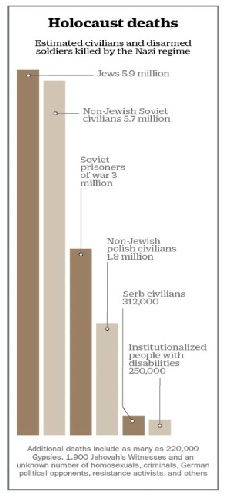
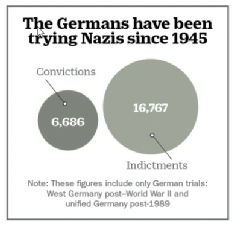
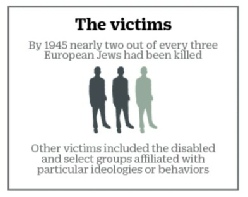
From Time, 2017
Go To Trials
|
Rape, Murder |
RESPONSIBILITY FOR THE HOLOCAUST
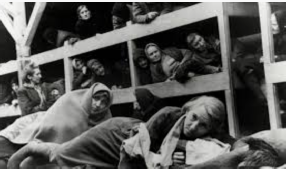
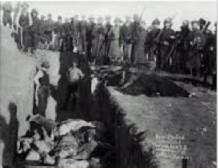
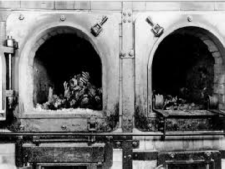
THE
INCREDIBLE
STORY OF THE JEWISH PEOPLE
